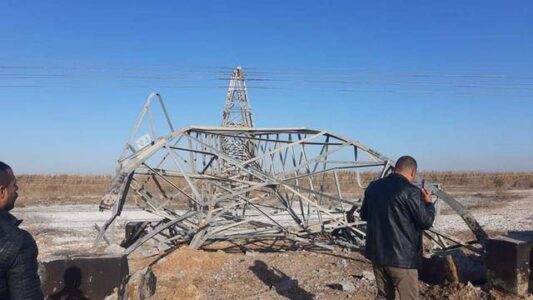
Islamic State terrorists bomb high-voltage power lines in militia stronghold near Baghdad
An ISIS attack on electricity pylons south of Baghdad caused several early morning explosions in an area held by Iran-backed hardline militia Kataib Hezbollah, official and militia sources told The National.
The incident in Jurf Al Sakhar, 65 kilometres south of Baghdad, was first reported as air strikes but militias operating in the area, the government and the US – which has troops in the country – denied this.
There were no reported fatalities or injuries from the explosions.
“Several electric power transmission towers in the Bahbahani area, north of the Babel governorate, were attacked and sabotaged by ISIS gangs. This was initially interpreted as airstrikes,” the Iraqi military said.
A security operation was launched shortly after the attack in search of militants in the area.
ISIS has not claimed responsibility for the attacks or commented on the accusation that they carried out the attack.
Despite the government announcing victory over ISIS in 2017, remnants and cells of the group still regularly stage hit and run attacks or plant explosives in areas across the country.
Several reports stated that security forces in the governorate had come under attack, but military sources refuted the claim.
Reports initially suggested that the US had conducted several air strikes on the area targeting Iranian backed militia groups. However, Captain Bill Urban, a spokesperson for the US Central Command, told The National that Washington was not involved.
“[The explosions] are not and were not the results of any US military action,” he said.
“I have seen reports of the explosion but have no independent knowledge of it,” Cpt Urban said.
Yehya Rasool, a spokesman for the Iraqi military, also said the reports of attacks on Iraqi security forces were wrong.
The Jurf Al Sakhar area was one of the main strongholds for Sunni militant groups such as Al Qaida in Iraq following the US-led invasion of 2003.
It came under the control of the insurgents in June 2014, but they were driven out a few months later by security forces.
Since then, thousands of Sunnis who fled the town have been unable to return as it is under the control of powerful Iran-backed Shiite militias, including Kataib Hezbollah. There are few government-security forces on the ground in the area.
Sunni politicians have repeatedly called for their community to return to the area, but their calls have been unheard.
The attack is just the latest by ISIS against Iraq’s electricity infrastructure in remote areas as it seeks to destabilise the government.
It coincides with other attacks against high voltage power lines in remote areas such as the eastern province of Diyala and the northern provinces of Kirkuk and Salahuddin, causing massive power outages, according to security forces.
The explosions came as US Secretary of State Mike Pompeo tweeted his recollection of an attempted storming of the US embassy by Iran backed militias and their supporters in December 2019, as news of the explosions in Jurf Al Sakhar were reported.
“When violent protestors attacked the US Embassy on New Year’s Eve 2019, US State Department special agents defended the compound against the mob for more than 40 hours, with no loss of life or serious injuries,” Mr Pompeo said.
The US and Iran came close to war after the US hit several Iran-backed militia groups in late 2019 in response to attacks on US forces.
Washington then launched an airstrike that killed Iranian general Qassem Suleimani and top Iraqi militia leader Abu Mahdi Al Muhandis on January 3 last year, just outside Baghdad’s airport.
In retaliation, Tehran fired rockets at Iraqi bases hosting American forces, causing brain injuries to dozens of soldiers.
Over the past year, Iranian allies in Iraq have attacked US and international troops – killing several – and the Baghdad embassy. The US has retaliated by launching air strikes against militia groups.
Baghdad accuses “outlaw groups” of launching the attacks but Washington blames Iranian-backed militias. The attacks have often been claimed by fringe and formerly little heard of groups that experts say are a smokescreen for the Popular Mobilisation Forces, an umbrella grouping of militias sanctioned by the government but often supported and funded by Iran.
Source: The National News





